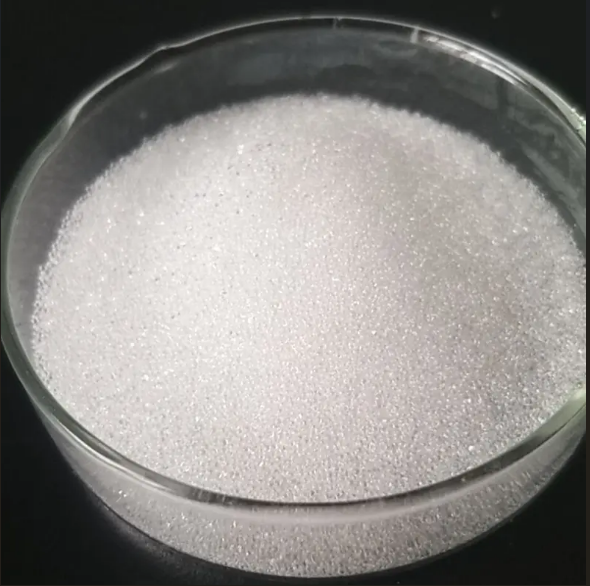



| Item | Index | |
|---|---|---|
| Appearance | Milky semitransparent spherical grain | |
| Ionic form | Cl | |
| Moisture content % | 57.00-63.00 | |
| Total exchange capacity mmol/g | ≥4.60 | |
| Strong group exchange capacity mmol/g | 40.0-60.0 | |
| Total exchange capacity mmol/ml | ≥1.40 | |
| Shipping weight g/ml | 0.68-0.73 | |
| True density g/ml | 1.05-1.10 | |
| Particle size range % | (0.315-1.25mm)≥95.0 | |
| Lower limit size % | (<0.315mm)≤1.0 | |
| The effective size mm | 0.45-0.70 | |
| Uniformity coefficient | ≤1.60 | |
| Sphericity after attrition % | ≥85.0 | |
| PH range | 1-14 | |
| Max. operation temperature in H form °C | 40 | |
| Swelling upon complete conversion (Cl--OH-) % | ≤10 | |
| Working exchange capacity mmol/L | ≥8 00 | |
| Working flow rate m/h | 10-25 | |
| Packing | in 25kg bags |
|---|---|
| Storage | 20°C,2 years |
| Shipping | Room temperature in China;may vary elsewhere |
Tel: 0086 25 52397805
Email: info@nj-finechem.com

| Common Names | Wang resin | ||
|---|---|---|---|
| Structure |  |
||
| CAS No. | 201058-08-4 | Boiling Point (℃) | 386.2ºC at 760 mmHg |
| Molecular Weight | 228.286 | Melting Point (℃) | N/A |
| Appearance | Off-white to beige beads | Vapor Specific Gravity | - |
| HS Code | 3909400000 | Flash Point (℃) | 175.2ºC |
| Solubility | - | Autoignition Temperature (℃) | - |
| Safety Phrases | 26-36/37/39-24/25 | ||
|---|---|---|---|
| RIDADR | 2211 | ||
| WGK Germany | 3 | ||
| Packaging Group | III | ||
| Hazard Class | - | ||
| SYMPTOMS | PREVENTION | FIRST AID | |
| Inhalation | poisonous | wear a mask | fresh air,keep breath comfortable |
| Skin | skin burn | wear protective clothing | Remove all soiled clothing and wash your skin with water. |
| Eyes | eye injury | wear goggles | Rinse slowly and gently with water for a few minutes |
| Ingestion | poisonous | Do not eat, drink or smoke while using this product | Call a POISON CENTRE or doctor |

What is ZGA 314 strongly and weakly basic acrylic acid series anion exchange resin?
Anion exchange resins are ion exchange resins that contain basic groups in their molecules. It is
basic in solution and can exchange anions in solution with its hydroxyl ions. It can be divided into
three categories: strongly alkaline, weakly alkaline, and a mixture of strongly and weakly
alkaline.
It is used for the removal of harmful anions (such as cyanide ion, thiocyanate ion, etc.) from
wastewater in the treatment of water (including softening of hard water, high-pressure boiler water,
non-ionized water, water for injection, seawater desalination, etc.), the extraction of rare
elements, and the separation of amino acids, vitamin C, tartaric acid, and citric acid. Includes
strong alkaline, weak alkaline and strong and weak alkaline.
How is ZGA 314 strongly and weakly basic acrylic acid series anion exchange resin stored and distributed?
Ion exchange resin contains a certain amount of water, should not be stored in the open air, the storage and transportation process should be kept wet, so as to avoid wind drying and dehydration, so that the resin broken, such as storage process of the resin dehydrated, it should be soaked in concentrated saline (25%), and then gradually diluted, shall not be put into the water directly, so as to avoid the resin rapid expansion and broken. In winter storage and transportation use, it should be kept in the temperature environment of 5-40℃, avoiding overcooling or overheating, which will affect the quality, if there is no heat preservation equipment in winter, the resin can be stored in the brine, and the concentration of brine can be determined according to the air temperature.
What is ZGA 314 strongly and weakly basic acrylic acid series anion exchange resin used for?
Anion exchange resin can be used for water treatment (such as hard water softening, desalination,
etc.), removal of harmful anions (such as cyanide ions, thiocyanate ions, etc.) in wastewater,
separation of amino acids, vitamin C, tartaric acid, and extraction of rare elements.
Because the ion exchange resin is a kind of excellent performance of controlled and slow release
carrier, the loaded phosphorus has the effect of controlled and slow release, which greatly improves
the absorption and utilization rate of phosphorus, reduces the waste of phosphorus resources and
phosphorus pollution to the environment; and the anion exchange resin based on the phosphorus source
of feed additives is easy to be mixed with the feed, the formation of a homogeneous dispersion
system, and easy to use.
Anion The regeneration solution of anion exchange resin is recycled to produce monosodium glutamate
(MSG). Separation of nucleotides from ribonucleic acid digest with anion exchange resin. Most of the
impurities in the enzymatic solution are trapped in the anion exchange resin or washed off by the
separation. The method of the present invention, has the advantages of low resin consumption, low
cost, high yield, good separation effect, high purity of the obtained product and suitability for
large-scale industrialized production.
Since the ion exchange resin is a controlled and slow-release carrier with excellent performance, it
has a controlled and slow-release effect on the loaded vanadium, thus greatly improving the
absorption and utilization of vanadium. The vanadium supplement of the present invention is
characterized by low toxicity and high efficiency and can be used as a vanadium supplement feed
additive; it can also be used in the preparation of oral vanadium supplements for human beings and
supplements and medicines for the treatment of human diseases by administering therapeutic vanadium.